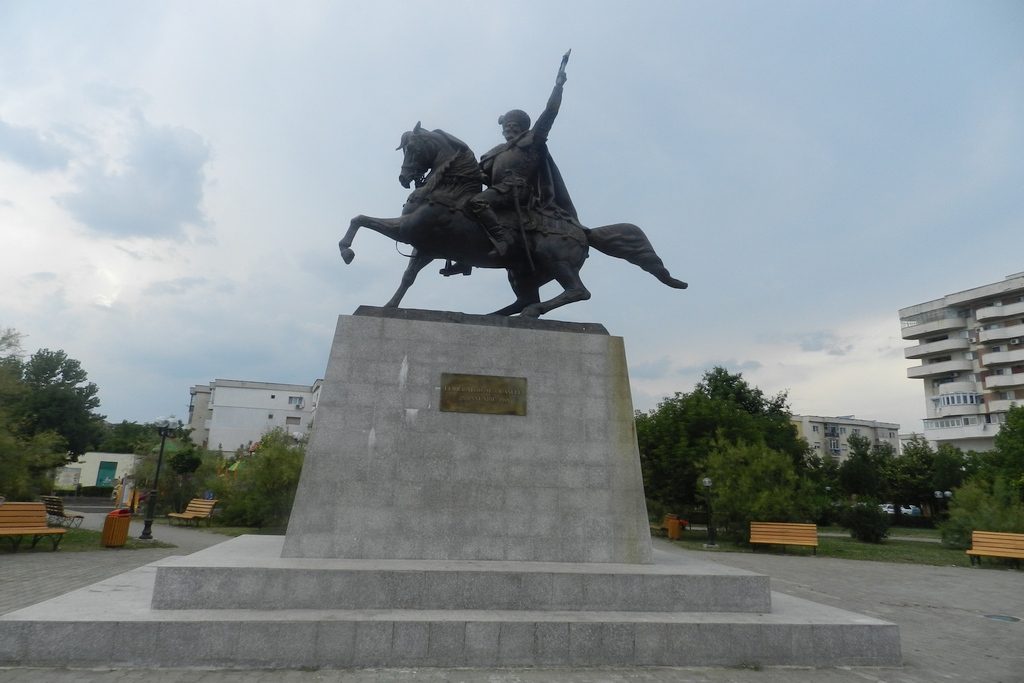

The Equestrian Statue of Michael the Brave in Giurgiu was carried out at the initiative of the Mayor of Giurgiu, Lucian Iliescu, an artist from Constanta, which conducted and the equestrian statue of Michael the Brave in Năvodari, inaugurated on 15 August 2011, as a replica of the statue Michael the Brave Bucharest.
The mayor’s intention was to locate it inside the roundabout nearby the Emergency Hospital from Giurgiu county.
The statue, casted in bronze in Turkey, like the other one from Navodari, was brought to Giurgiu on 30th of May 2012 and it was provisionally discharged near the city park.
From its height of seven meters, the equestrian statue of Michael the Brave dominates the market that bears his name. The base on which rests prince who unified the nation and the country, is of 4.7 meters high and was placed on a platform equipped with three access ramps. The platforma is decorated with bas reliefs, whereby the sequences of the fights are drawn from the battles fought by Prince Michael the Brave with the Ottomans, as well as the moments marking the unification of Moldavia and Transylvania with the Romanian Country. Under the emblem there is an inscription, which reads as follows: „Mihai Viteazul, 1593-1601, Domnul Ţării Româneşti, al Ardealului şi a toată Ţara Moldovei” (“Michael the Brave, 1593-1601, the Lord of the Romanian Country, of Transylvania and the whole country of Moldova”.). The monument inaugurated in 1967 and it is the opera of the sculptor Marius Butonoiu..
Following the local elections of 10 June 2012 in Giurgiu another mayor was elected.
The new mayor of Giurgiu, Nicolae Barbu has launched a public consultation and has asked for the architects and specialists opinion from the County Museum, following which it was decided that the equestrian statue of the Prince Mihai Viteazu to be placed in the central area of the park, that bears his name, and not in the middle of the street, where passengers access is impossible.
At the beginning of works it was discovered that an important drinking water pipe passes under the place determined, so that the architects a little changed the space form, from circular to oval, the statue being visible due to high plinth, in steps, designed thus to come into contact with people and not just as an inserted object.. Its steps will be used as a resting place for young people, reading, conversation, the architect Anne Marie Gacichevici appreciated, an adviser within the Municipality.
On August 30th, 2012, the statue was raised on the pedestal located in the Mihai Viteazul park.
Born in 1557, Michael the Brave became the ruler of Wallachia in the autumn of 1593, simultaneously being the ruler of Transylvania between 1599 şi 1600, and ruler of Moldova in 1600.
Facing with the great powers of that time- Ottomans, Hapsburgs, Poles, Michael the Brave did what none of his predecessor succeeded, achieving – for a short tiem -the independence dubled by the national unity.
Victoriously in Calugareni, Targoviste and Giurgiu, then Şelimbar and Guruslau, defying the power of Ottoman armies and those of Andrew Báthory, the prince of Transylvania and overlord of Wallachia, as well as of defying the armies of Poland in Moldova, Michael the Brave became “Restitution Daciae.” On 1st of November 1599, Alba Iulia city became the capital of all Romanians, the ruler bringing under his control „şi hotarul Ardealului, pohta ce-am pohtit, Moldova, Ţara Romanească!” – (the borders of Transylvania, is what I wanted, Moldova, Romanian Country.”
In the morning of August 19 he was assassinated by order of Emperor Rudolf the IInd by General Gheorghe Basta.
